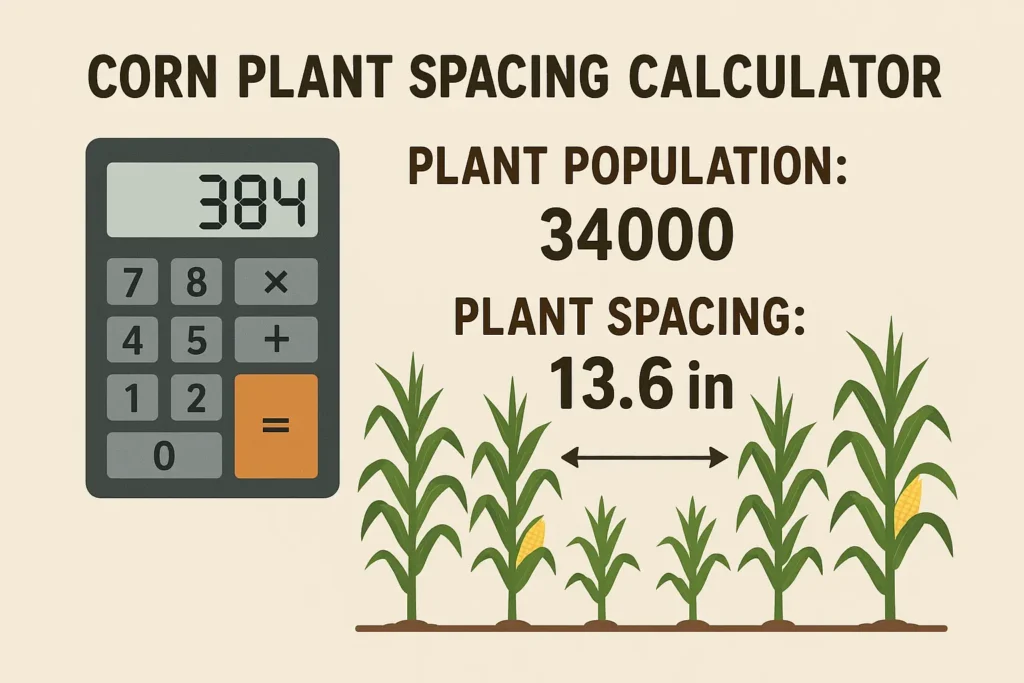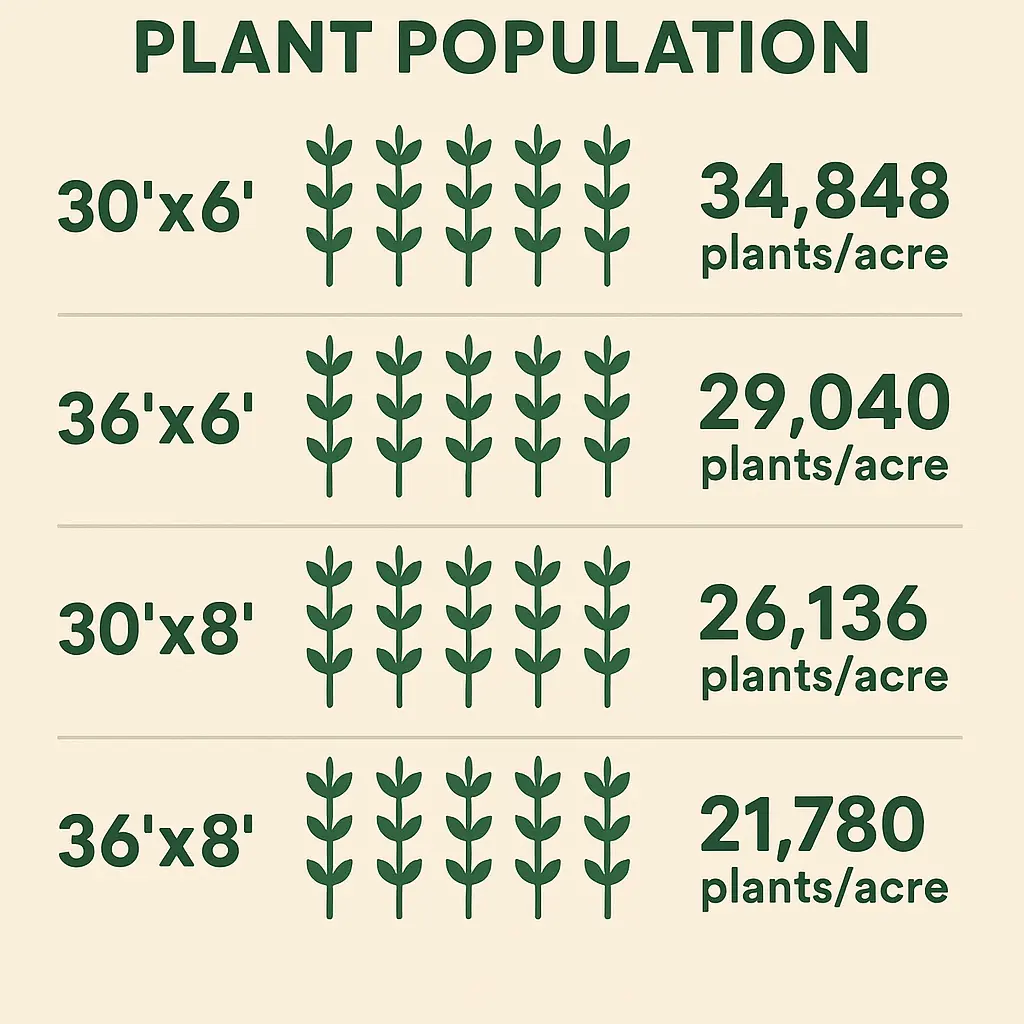🌽 Corn Plant Spacing Calculator
Optimize your corn planting density for higher yields, improved nutrient uptake, and efficient water usage.
Corn Plant Spacing Calculator: Find the Ideal Distance for Higher Yields

Created by James S. Lockwood
With a background in botany and ecological sciences, James specializes in creating practical tools and resources to help gardeners, farmers, and plant enthusiasts optimize their green spaces.
If you’ve ever wondered whether you’re planting your corn too close together—or too far apart—you’re not alone. Corn plant spacing is one of those quietly powerful decisions that can make or break your harvest. And while the “standard” advice seems to be 6 to 8 inches between plants with 30-inch rows, the reality is more nuanced than a one-size-fits-all guideline.
That’s where a Corn Plant Spacing Calculator becomes more than just a tool—it becomes your silent planting partner.

Table of Contents
Why Corn Spacing Matters More Than You Think?
Spacing isn’t just about fitting plants in a row. It’s about managing pollination, airflow, root development, and competition for nutrients. Corn is wind-pollinated. If you overcrowd, you might get poor pollination. Too sparse, and you could be wasting valuable field real estate.
In high-yield environments, many growers experiment with tighter row spacing—like 20 inches instead of 30. Others argue that unless you’re also increasing population density and managing fertility, the gains are minimal. It’s not that one side is wrong; it’s that what works depends on your hybrid, your goals, and your resources.
The “Standard” Corn Spacing—And Why It’s Not Always Ideal
Ask around and you’ll hear this rule repeated often: 30-inch rows, 6–8 inches between plants. It’s a reliable baseline. But here’s where things get interesting:
Dryland growers in low-moisture zones often stretch the plant spacing to 9 or 10 inches to reduce stress.
Irrigated setups, by contrast, sometimes go as tight as 5.5 inches to push population limits.
Hybrid genetics also matter—a plant bred for aggressive early growth may need more breathing room than a slower-developing variety.
That’s why using a corn plant spacing calculator can be a smarter move than guessing. It accounts for these variables instead of relying on broad averages.
Corn Spacing by Hybrid Type
Not all corn hybrids thrive under the same conditions. The genetics of your seed can significantly affect optimal spacing. Here’s a quick reference guide based on common hybrid categories.
Early-Maturing Hybrids
Row Spacing: 30 inches
Plant Spacing: 7–9 inches
Shorter growing season; may benefit from wider in-row spacing to reduce stress.
High-Yield Hybrids
Row Spacing: 20–30 inches
Plant Spacing: 5.5–7 inches
Designed for denser populations; requires better fertility management.
Drought-Tolerant Hybrids
Row Spacing: 30–36 inches
Plant Spacing: 8–10 inches
Wider spacing improves moisture access and root spread in dry conditions.
Silage Hybrids
Row Spacing: 30 inches
Plant Spacing: 6–8 inches
Higher biomass production allows for slightly tighter spacing.
Stacked-Trait Hybrids
Row Spacing: 30 inches
Plant Spacing: 6–7.5 inches
Balanced growth; performs well with standard row setups and moderate density.
Corn Spacing and Plant Population: Finding the Balance

The ideal population isn’t always intuitive. You might assume that denser planting equals more yield—but that’s not always the case. Overcrowding can lead to weak stalks, pest issues, and poor ear fill.
For example, aiming for 34,000 plants per acre might be perfect in Nebraska with high fertility and irrigation. But in drier zones, even 28,000 might be pushing it.
Use a spacing calculator to test different plant populations based on your row width and target yield—or calculate your plant population per acre directly to find the sweet spot before you plant.
Why Proper Corn Plant Spacing Matters: More Than Just Numbers?
It’s tempting to think of corn spacing as just a math problem—divide your field by the number of seeds and call it a day. But behind the math are plant physiology, wind behavior, and soil dynamics that quietly influence every ear you harvest.
1. Wind Pollination Requires Precision
Corn is a monoecious, wind-pollinated crop, meaning it produces both male (tassels) and female (silks) parts on the same plant, and the pollen needs to drift through the air to land on the silks of neighboring plants. That only works efficiently if:
Plants are neither too close nor too far apart.
There’s uniformity in plant height and development.
Overly dense planting can create microclimates with stagnant air, reducing pollen movement. Conversely, if plants are too widely spaced, pollen may drift away before it reaches target silks, especially on windy days. An optimal distance ensures pollen hits its mark while maximizing ear fill.
2. Spacing Influences Root Competition and Water Access
Corn roots don’t just go down—they spread wide. If you plant too close together, roots start to compete below the surface even before the leaves start shading each other. That competition:
Limits water uptake, especially critical in dry years.
Reduces nutrient access, particularly nitrogen and phosphorus.
Increases vulnerability to lodging (falling over due to weak root anchoring).
On the other hand, if spacing is too generous, you might be underutilizing available moisture, especially in high-fertility, irrigated environments.
3. Photosynthesis and Canopy Closure
Proper plant spacing encourages even canopy development, which:
Maximizes sunlight capture during the growing season.
Reduces weed pressure by shading out intruders.
Maintains airflow, lowering the risk of foliar diseases.
Interestingly, narrower row spacing often accelerates canopy closure, which may benefit some hybrids more than others. That’s why a one-size-fits-all approach doesn’t always hold up.
4. Environmental Feedback Loops
Spacing decisions also impact how well corn responds to stress. In tighter spacing:
Plants may shade each other out if not uniformly emerged.
Heat stress can become more intense due to limited airflow.
Disease risk climbs due to higher humidity around leaves.
But there’s a tradeoff—more plants can mean more ears per acre in ideal conditions. So, it’s not about tighter or wider rows being inherently better. It’s about knowing how your environment responds and using a corn plant spacing calculator to model those choices before planting begins.
Visualizing Corn Spacing: A Simple Way to Make Better Decisions
Sometimes, seeing is understanding. One useful feature in our Corn Plant Spacing Calculator is the visual breakdown of plant distribution by acre.
You can compare, for instance:
30″ rows with 6″ plant spacing = ~34,848 plants/acre
30″ rows with 8″ spacing = ~26,136 plants/acre
20″ rows with 6″ spacing = ~52,272 plants/acre
That’s a significant swing, and not all soils—or wallets—can support such densities. Seeing those numbers laid out helps avoid under- or overplanting, especially for new growers. If you’re unsure, start conservative and adjust once you’ve monitored one full season.
Hybrids, Conditions, and Gut Feel: The Human Factor
Data can guide you, but intuition matters too. Some growers swear that “you can just tell” when a field is too crowded by looking at leaf overlap or early-season vigor. Others rely strictly on numbers and trials.
You might try 30-inch rows at 7-inch spacing this season and find the results don’t justify the extra seed cost. That’s why the calculator isn’t just for pre-season planning—it’s a tool for post-season learning, too.
If you want a broader comparison across crops, check out our Garden Plant Spacing Calculator to see how different spacing rules apply beyond just corn.
How to Use the Corn Plant Spacing Calculator?
Using it is straightforward. You input:
Your row spacing (in inches)
Your plant spacing within the row (in inches)
Optionally, your field size (in acres)
It calculates your total plant population and spacing efficiency. It’s especially useful when you’re experimenting with a new hybrid or switching between dryland and irrigated plots.
You can even pair this with our Fertilizer Calculator to see how changes in plant population affect nutrient requirements.
FAQ: Corn Plant Spacing Questions Answered
What is the spacing for corn plants?
A: The general guideline is to space corn plants 6 to 8 inches apart within each row. However, this may vary based on hybrid type, moisture availability, and whether you’re growing for grain or silage. Wider spacing (up to 10 inches) may be used in dryland conditions to reduce competition.
What is the best row spacing for corn?
A: Most growers stick with 30-inch row spacing because it’s compatible with standard equipment. That said, some high-density systems use narrower rows—like 20 or 22 inches—to increase plant population and sunlight efficiency. Whether it’s better depends on hybrid choice, soil fertility, and your yield goals.
How to calculate plant population by spacing?
A: Plant population is calculated using this formula:
(43,560 ÷ row spacing in feet) ÷ plant spacing in feet = plants per acre.
For example, with 30-inch rows and 6-inch plant spacing, you’d have around 34,848 plants per acre. You can use our plant population calculator to do the math instantly.
How close can you plant corn next to each other?
A: Corn can be planted as close as 5.5 inches in some high-yield irrigated systems, but this requires excellent nutrient management and hybrid selection. For most growers, 6 to 8 inches is the safe range. Planting too close risks poor pollination and smaller ears due to competition for light and nutrients.
Final Thoughts: Use Tools, But Trust Experience
There’s no perfect number when it comes to corn spacing. But there is a sweet spot for your field, your hybrid, and your growing season. The Corn Plant Spacing Calculator helps you find it—quicker, easier, and more confidently.
Try it. Adjust it. And most importantly—observe. That combination of calculation and careful watching often beats either method alone.
Because sometimes, the best yield doesn’t come from just following rules—it comes from knowing when to bend them.
Disclaimer for Corn Plant Spacing Calculator
The Corn Plant Spacing Calculator provides estimates only and should not replace professional agronomic advice. Actual planting results may vary based on soil conditions, climate, seed variety, and farming practices. Always consult with an agricultural expert before making planting decisions. We are not responsible for any inaccuracies or crop losses resulting from the use of this tool.
Discover Crop & Farming Calculators
